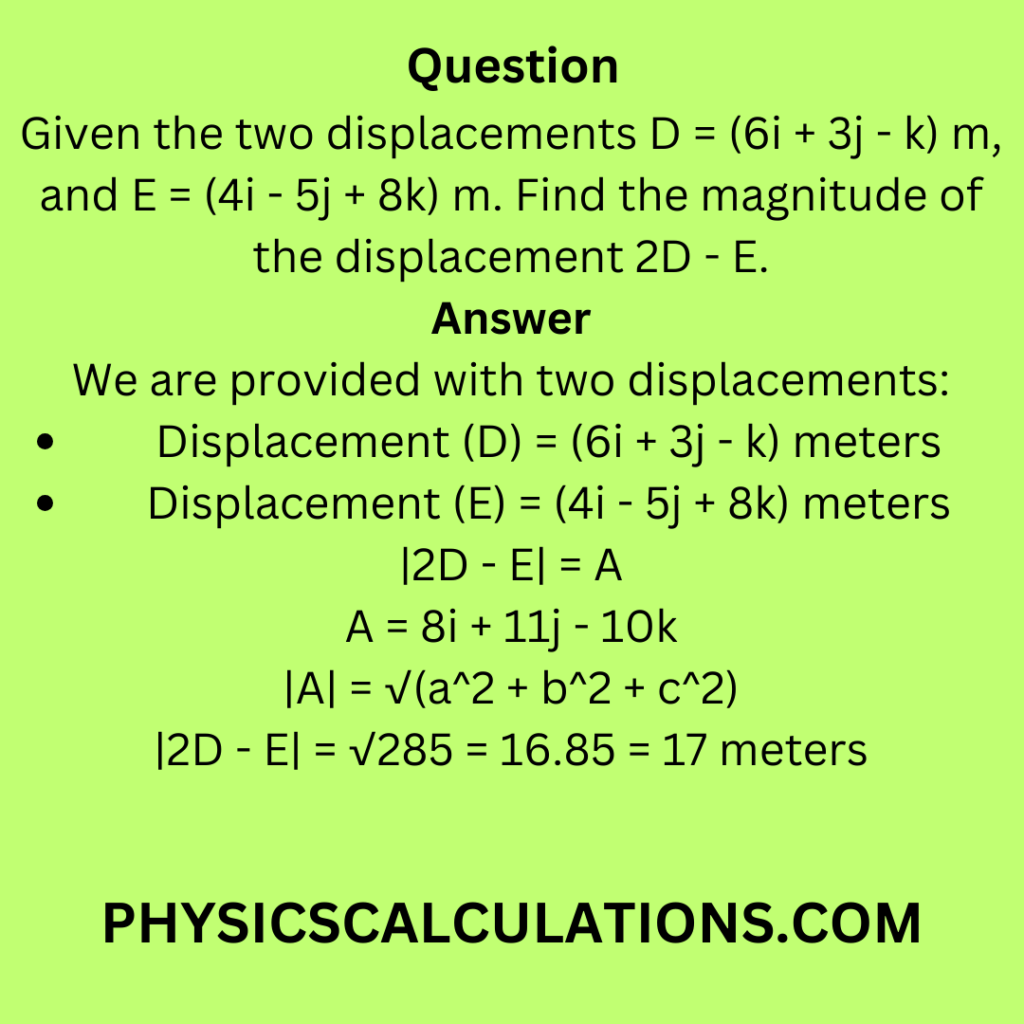Question
Given the two displacements D = (6i + 3j – k) m, and E = (4i – 5j + 8k) m. Find the magnitude of the displacement 2D – E.
Answer
Our objective is to find the magnitude of the displacement resulting from the operation (2D – E), where (D) and (E) are given displacements.

Data:
We are provided with two displacements:
- Displacement (D) = (6i + 3j – k) meters
- Displacement (E) = (4i – 5j + 8k) meters
You may also like to read:
What is the acceleration of a 50 kg object pushed with a force of 500 newtons?
Unknown:
We need to find the magnitude of the displacement (2D – E) = ?
Formula:
To solve this problem, we’ll apply vector algebra, specifically vector addition and scalar multiplication, and then find the magnitude of the resulting vector. The formula to find the magnitude of a vector
A = ai + bj + ck is:
|A| = √(a2 + b2 + c2)
Where a, b, and c are the coefficients of the i, j, and k unit vectors, respectively.
Solution:
First Step:
Let’s begin by identifying the given data:
- Displacement (D) = (6i + 3j – k) meters
- Displacement (E) = (4i – 5j + 8k) meters
Second Step:
Now, we will perform the operation (2D – E) to find the resulting displacement. This involves scalar multiplication and vector subtraction:
(2D – E) = (2(6i + 3j – k) – (4i – 5j + 8k))
Simplify this expression:
(2D – E) = (12i + 6j – 2k – 4i + 5j – 8k)
Combine like terms:
(2D – E) = ((12i – 4i) + (6j + 5j) + (-2k – 8k))
(2D – E) = (8i + 11j – 10k)
Third Step:
Now, we have the resulting displacement (2D – E) as (8i + 11j – 10k) meters.
Fourth Step:
To find the magnitude of this displacement, we’ll apply the magnitude formula for a vector A = ai + bj + ck:
|A| = √(a2 + b2 + c2)
In our case, A = 8i + 11j – 10k, so:
|2D – E| = √(82 + 112 + (-10)2)
Let’s calculate this:
|2D – E| = √(64 + 121 + (100)
Thus,
|2D – E| = √285 = 16.85 = 17 meters
Explanation:
The magnitude of the displacement resulting from the operation (2D – E), where (D) and (E) are given displacements, is equal to the square root of 285. The result is approximately 16.85 meters or approximately 17 meters.
In vector algebra, when we perform scalar multiplication and vector subtraction as we did in this problem, we obtain a new displacement vector, (2D – E). The magnitude of this new vector represents the length or distance of the combined displacement in space.
This type of problem is common in physics, especially in situations involving the analysis of multiple motions or changes in position. By using vector algebra, we can accurately describe and calculate such displacements, providing crucial insights into the motion of objects or points in a three-dimensional space.
In summary, the magnitude of the displacement (2D – E) is approximately 16.85 meters, calculated using vector algebra and the magnitude formula.